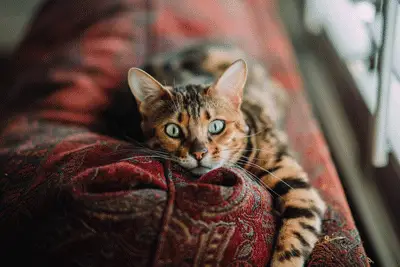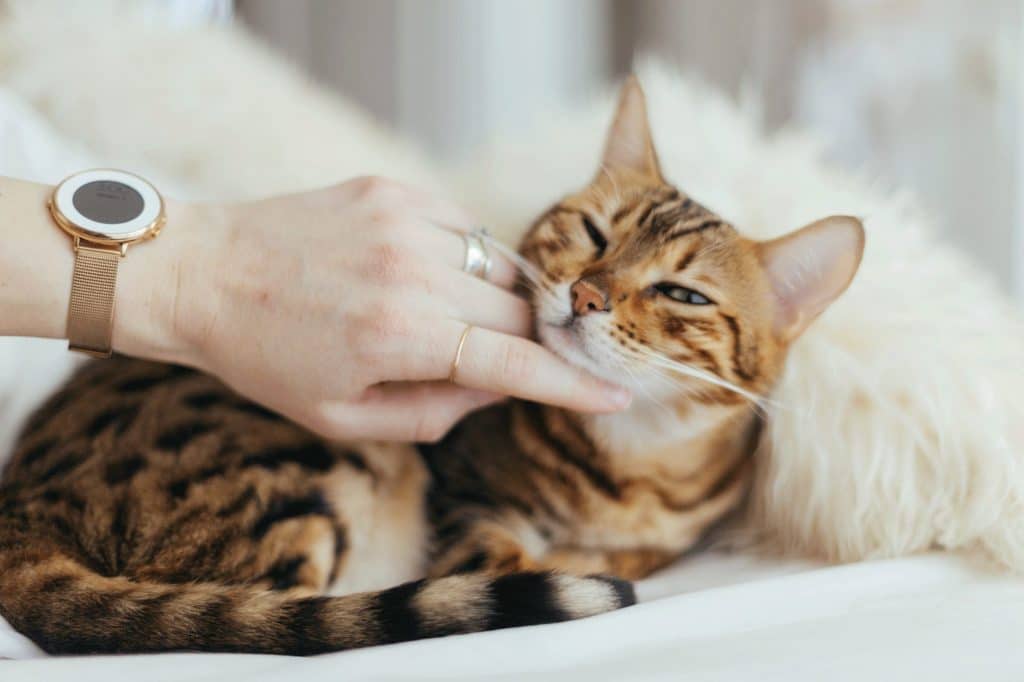No one wants to believe their healthy, energetic Bengal cat could possibly have any health issues, but the reality is that all cats (especially purebreds) are susceptible to certain diseases and disorders. Staying informed on some of the most common health issues in Bengals can help you make the right decision about whether to see a vet if something seems off, and catching problems early can be essential.
- Cataracts
- Progressive Retinal Atrophy
- Hypertrophic Cardiomyopathy
- Anesthetic Allergies
- Luxating Patella
- Distal Neuropathy
- Entropion
Cataracts
A cataract is when the eye becomes opaque due to inherited factors or injury. Like in humans, cataracts in Bengal cats can be treated with surgery, and leaving a cataract untreated can result in blindness or glaucoma.
Cataracts usually only happen in older Bengal cats, but in rare cases could occur in younger Bengals. They’re fairly easy to detect as they look like a cloudy, opaque film over the Bengal cat’s eye.
Progressive Retinal Atrophy
Progressive retinal atrophy is a conditional that causes the deterioration of the retina’s rods and cones, eventually resulting in blindness. More and more young Bengal’s are being diagnosed with this condition, some as young as 3 months of age.
It’s particularly important to be aware of progressive retinal atrophy because there is currently no genetic tests to screen for it. This means that your Bengal cat’s breeder won’t be able to indicate if your Bengal is at risk of developing this disorder.
Hypertrophic Cardiomyopathy
Hypertrophic cardiomyopathy is a disorder where the wall of the heart thickens, making it hard for the heart to pump blood to the rest of the body. While it’s usually only seen in older Bengal cats, it’s fairly common in the Bengal cat breed in general. If left untreated, hypertrophic cardiomyopathy will almost always result in death.
Signs of this disorder include panting and lethargy. Breeders will also oftentimes test for this disorder and discontinue breeding Bengals that are positive for the gene.
Anesthetic Allergies

Bengal cats are particularly sensitive to the anesthetics used by vets even in minor surgeries such as spaying and neutering. In some of the worst cases, Bengals can experience cardiac arrest from an allergic reaction to the anesthetics. Your vet is likely already well aware of this risk factor in Bengal cats and will make appropriate recommendations on surgical procedures for your cat.
Luxating Patella
A luxating patella is where the kneecap slips out of alignment from the rest of the leg and can cause pain and problems with movement. This condition is hereditary and caused by malformation of the knee join in utero.
It’s possible to correct a luxating patella with surgery, but the earlier you can catch it, the better.
Distal Neuropathy
Distal neuropathy is when the nerve endings degenerate and demyelinate, causing decreased muscle tone, strength and reflexes. About 9% of Bengal cats seem to have some form of distal neuropathy, and the age of onset is about the 1 year mark for a Bengal cat (much younger than onset in most cats).
About 60% of Bengal cats make a full recovery from the disorder, and early onset is strongly associated with a full recovery.
Diagnosing distal neuropathy can be difficult, but general weakness in the cat seems to be one of the most prominent signs.
Entropion
Another common eye disorder in Bengal cats is entropion, which is where the eyelid turns inward and can cause irritation and infection in the eye if left untreated.
It’s important to get this condition treated as quickly as possible, and surgery is almost always required to return the eyelid to it’s normal state.
Signs that your Bengal cat might be suffering from entropion include: constant blinking, mucus discharge from the eye, squinting, swollen eyelids, aversion to light, and pawing at the eyes.














